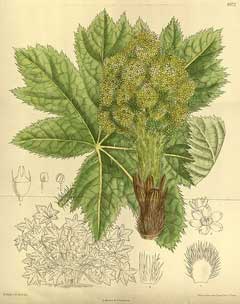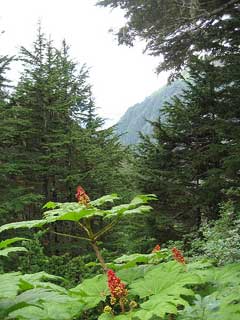 |
|
http://commons.wikimedia.org/wiki/File:Echinopanax_horridus_140-8572.jpg |
 |
| http://www.flickr.com/people/24915707@N00 |
Translate this page:
Summary
Physical Characteristics

 Oplopanax horridus is a deciduous Shrub growing to 2 m (6ft) by 2 m (6ft).
Oplopanax horridus is a deciduous Shrub growing to 2 m (6ft) by 2 m (6ft).
See above for USDA hardiness. It is hardy to UK zone 4 and is not frost tender. It is in flower from June to August. The species is hermaphrodite (has both male and female organs).
Suitable for: light (sandy), medium (loamy) and heavy (clay) soils. Suitable pH: mildly acid, neutral and basic (mildly alkaline) soils. It can grow in full shade (deep woodland) or semi-shade (light woodland). It prefers moist soil. The plant can tolerate maritime exposure.
UK Hardiness Map
US Hardiness Map
Synonyms
Echinopanax horridus. Fatsia horrida. Panax horridum.
Plant Habitats
Woodland Garden Dappled Shade; Shady Edge; not Deep Shade;
Edible Uses
Edible Parts: Leaves Root Shoots
Edible Uses:
Young shoots - peeled and then cooked[46, 61, 105, 106]. Only the very young shoots are used[172]. The roots can be chewed after peeling[105, 106, 161].
References More on Edible Uses
Medicinal Uses
Plants For A Future can not take any responsibility for any adverse effects from the use of plants. Always seek advice from a professional before using a plant medicinally.
Analgesic Antidandruff Antiphlogistic Antirheumatic Hypoglycaemic Parasiticide Parasiticide Tonic
Devil's club was widely employed medicinally by several native North American Indian tribes who used it especially for its pain-relieving properties[257]. It is little, if at all, used in modern herbalism, though it probably merits further investigation. The root bark and stems are analgesic, antirheumatic, antiphlogistic, appetizer, blood purifier, cathartic, emmenagogue, galactogogue, hypoglycaemic, ophthalmic, pectoral and tonic[172, 157]. An infusion is used in the treatment of coughs and colds, bronchitis, tuberculosis, stomach problems etc[257]. A decoction is drunk in the treatment of rheumatism and is also applied externally as a wash on the affected joints[257]. A poultice of the bark has been used to relieve pain in various parts of the body[257]. A poultice of the bark has been applied to a nursing mother's breasts in order to stop an excessive flow of milk[257]. A decoction has been used as an eye wash in the treatment of cataracts and as a herbal steam bath for treating general body pains[257]. The burnt stems, mixed with oil, are applied as a salve on swellings[257]. An extract of the root bark lowers blood sugar levels and an infusion of the bark has been used in the treatment of diabetes[213]. The infusion also has a tonic effect on the blood and liver[213]. The inner bark is emetic in large doses and purgative (especially if taken with hot water)[257]. It is used in the treatment of coughs and colds, stomach and bowel cramps[257]. A poultice of the inner bark is used in the treatment of wounds, sores etc[257]. The berries have been rubbed on the scalp to combat lice and dandruff, and to make the hair shiny[256].
References More on Medicinal Uses
The Bookshop: Edible Plant Books
Our Latest books on Perennial Plants For Food Forests and Permaculture Gardens in paperback or digital formats.

Edible Tropical Plants
Food Forest Plants for Hotter Conditions: 250+ Plants For Tropical Food Forests & Permaculture Gardens.
More

Edible Temperate Plants
Plants for Your Food Forest: 500 Plants for Temperate Food Forests & Permaculture Gardens.
More

More Books
PFAF have eight books available in paperback and digital formats. Browse the shop for more information.
Shop Now
Other Uses
Parasiticide Parasiticide
The berries can be mashed into a pulp and then rubbed onto the scalp to get rid of head lice[257].
Special Uses
References More on Other Uses
Cultivation details
Requires a cool moist soil[11, 200]. Prefers a position in light shade[182]. Prefers dense shade and is probably best if grown in moist woodland[1, 11]. Tolerates maritime exposure[200]. (Rather a strange report for a plant that needs to be grown in dense shade[K]). A very hardy plant, tolerating temperatures down to at least -15°c, but the young shoots in spring can be damaged by late frosts[11, 200]. It is therefore best not grown in a frost pocket[182]. This species was until recently considered to have its range in N. America and Japan, but the Japanese form has now been separated off into its own species as O. japonicus[200]. A very ornamental plant, but it is densely armed with spikes[60]. It transplants easily and also tolerates pruning[200]. The leaves and stems are excessively spiny[182].
References Carbon Farming Information and Carbon Sequestration Information
Temperature Converter
Type a value in the Celsius field to convert the value to Fahrenheit:
Fahrenheit:
The PFAF Bookshop
Plants For A Future have a number of books available in paperback and digital form. Book titles include Edible Plants, Edible Perennials, Edible Trees,Edible Shrubs, Woodland Gardening, and Temperate Food Forest Plants. Our new book is Food Forest Plants For Hotter Conditions (Tropical and Sub-Tropical).
Shop Now
Plant Propagation
Seed - best sown in a cold frame as soon as it is ripe in the autumn[200]. When they are large enough to handle, prick the seedlings out into individual pots and grow them on in the greenhouse for at least their first winter. Plant them out into their permanent positions in late spring or early summer, after the last expected frosts. Division of suckers in the dormant season. Root cuttings in a greenhouse in the winter[188].
Other Names
If available other names are mentioned here
Native Range
NORTHERN AMERICA: Canada (Yukon (west), Ontario (southwest), Alberta, British Columbia), United States (Alaska (southwest), Michigan (Isle Royale), Idaho, Montana (west), Oregon, Washington)
Weed Potential
Right plant wrong place. We are currently updating this section.
Please note that a plant may be invasive in one area but may not in your area so it's worth checking.
Conservation Status
IUCN Red List of Threatened Plants Status :

Growth: S = slow M = medium F = fast. Soil: L = light (sandy) M = medium H = heavy (clay). pH: A = acid N = neutral B = basic (alkaline). Shade: F = full shade S = semi-shade N = no shade. Moisture: D = dry M = Moist We = wet Wa = water.
Now available:
Food Forest Plants for Mediterranean Conditions
350+ Perennial Plants For Mediterranean and Drier Food Forests and Permaculture Gardens.
[Paperback and eBook]
This is the third in Plants For A Future's series of plant guides for food forests tailored to
specific climate zones. Following volumes on temperate and tropical ecosystems, this book focuses
on species suited to Mediterranean conditions—regions with hot, dry summers and cool, wet winters,
often facing the added challenge of climate change.
Read More
Expert comment
Author
(Sm.)Miq.
Botanical References
1160200
Links / References
For a list of references used on this page please go here
Readers comment